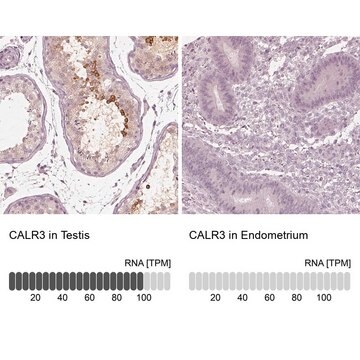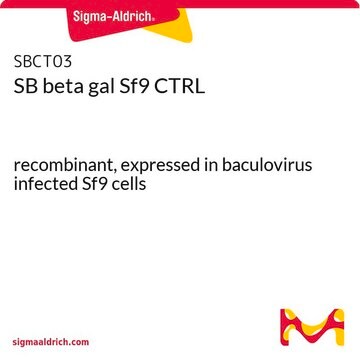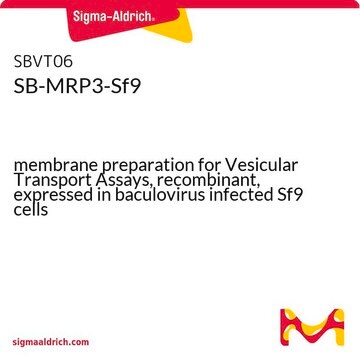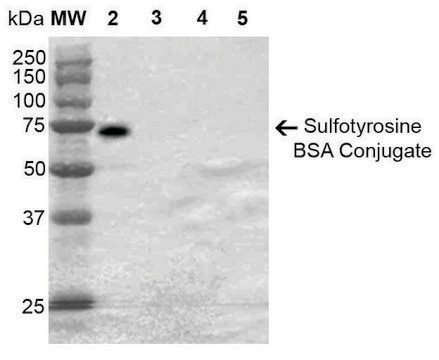おすすめの製品
リコンビナント
expressed in baculovirus infected Sf9 cells
形状
liquid
濃度
5 mg/mL
色
off-white
UniProtアクセッション番号
輸送温度
dry ice
保管温度
−70°C
遺伝子情報
human ... ABCC1(4363)
詳細
Membrane Preparations for Vesicular Transport Assays (VT) are suitable for general drug-efflux transporter interaction studies. Both substrate and inhibitor interactions can be assessed using vesicles. The success of substrate interaction studies strongly depends on the passive permeability of the compound. High permeability substrates might not be detected. Control Membranes with no-, or significantly lower transporter activity are also available.
アプリケーション
In the vesicular transport assay so-called "inside-out" membrane vesicles containing ABC transporters are applied. Incubating substrates of the respective efflux transporter in the presence of the inverted membrane vesicles and ATP will allow measuring accumulation of the substrates into the vesicles. In many cases radiolabeled reporter substrates are used but recently SOLVO developed the new PREDIVEZTM Vesicular Transport Kits that use fluorescent reporter substrates.
The standard vesicular transport assay is an inhibitory assay performed with cold test articles. This assay provides information on any interaction between the ABC transporter and the test article. The transport of the reporter substrate is measured in the presence of the test article (typically in 7 concentrations) and IC50 is defined as the concentration inhibiting the transport of the reporter substrate by 50%.
Should radiolabeled form of the investigated compound or adequate analytical methods (LC/MS, HPLC) be available, the vesicular transport assay may be performed in a direct format without the reporter substrate and may identify substrate nature of the test article. The vesicular transport substrate assay is a low throughput assay. It is suitable for low permeability test compounds as high permeability compounds may escape from the vesicles through the lipid bilayer.
PREDIVEZ vesicular transport kit is sold separately. This transporter membrane vesicle assay requires the PREDIVEZ vesicular transport kit and corresponding control membrane below:
SB PREDIVEZ Reagent Kit for MRP1 part number SBPVR2-9RXN and corresponding control membrane SB-beta-gal-Sf9-CTRL part number SBCT03-1EA
The standard vesicular transport assay is an inhibitory assay performed with cold test articles. This assay provides information on any interaction between the ABC transporter and the test article. The transport of the reporter substrate is measured in the presence of the test article (typically in 7 concentrations) and IC50 is defined as the concentration inhibiting the transport of the reporter substrate by 50%.
Should radiolabeled form of the investigated compound or adequate analytical methods (LC/MS, HPLC) be available, the vesicular transport assay may be performed in a direct format without the reporter substrate and may identify substrate nature of the test article. The vesicular transport substrate assay is a low throughput assay. It is suitable for low permeability test compounds as high permeability compounds may escape from the vesicles through the lipid bilayer.
PREDIVEZ vesicular transport kit is sold separately. This transporter membrane vesicle assay requires the PREDIVEZ vesicular transport kit and corresponding control membrane below:
SB PREDIVEZ Reagent Kit for MRP1 part number SBPVR2-9RXN and corresponding control membrane SB-beta-gal-Sf9-CTRL part number SBCT03-1EA
物理的形状
Supplied as frozen membrane vesicles, containing 5 mg/ml membrane protein, labeled with volume, catalog number (transporter) and date of production.
法的情報
SOLVO Biotechnology, Inc.より提供。
保管分類コード
12 - Non Combustible Liquids
WGK
WGK 1
引火点(°F)
Not applicable
引火点(℃)
Not applicable
適用法令
試験研究用途を考慮した関連法令を主に挙げております。化学物質以外については、一部の情報のみ提供しています。 製品を安全かつ合法的に使用することは、使用者の義務です。最新情報により修正される場合があります。WEBの反映には時間を要することがあるため、適宜SDSをご参照ください。
カルタヘナ法
カルタヘナ法
Jan Code
SBVT04-1EA:
試験成績書(COA)
製品のロット番号・バッチ番号を入力して、試験成績書(COA) を検索できます。ロット番号・バッチ番号は、製品ラベルに「Lot」または「Batch」に続いて記載されています。
Roger G Deeley et al.
Physiological reviews, 86(3), 849-899 (2006-07-04)
Multidrug Resistance Proteins (MRPs), together with the cystic fibrosis conductance regulator (CFTR/ABCC7) and the sulfonylurea receptors (SUR1/ABCC8 and SUR2/ABCC9) comprise the 13 members of the human "C" branch of the ATP binding cassette (ABC) superfamily. All C branch proteins share
J Wijnholds et al.
Nature medicine, 3(11), 1275-1279 (1997-11-14)
The multidrug resistance-associated protein (MRP) mediates the cellular excretion of many drugs, glutathione S-conjugates (GS-X) of lipophilic xenobiotics and endogenous cysteinyl leukotrienes. Increased MRP levels in tumor cells can cause multidrug resistance (MDR) by decreasing the intracellular drug concentration. The
Cornelius F H Mueller et al.
Circulation research, 97(7), 637-644 (2005-08-27)
Glutathione (GSH) is the major source of intracellular sulfhydryl groups. Oxidized GSH (GSSG) can be recycled to GSH by the GSH reductase or exported from the cell. The mechanism by which GSSG is exported and the consequence of its export
S-M He et al.
Current medicinal chemistry, 18(3), 439-481 (2010-12-15)
Multidrug ABC transporters such as P-glycoprotein (P-gp/MDR1/ABCB1) and multidrug resistance protein 1 (MRP1/ABCC1) play an important role in the extrusion of drugs from the cell and their overexpression can be a cause of failure of anticancer and antimicrobial chemotherapy. Recently
Eva Bakos et al.
Pflugers Archiv : European journal of physiology, 453(5), 621-641 (2006-12-26)
MRP1 (ABCC1) is a peculiar member of the ABC transporter superfamily for several aspects. This protein has an unusually broad substrate specificity and is capable of transporting not only a wide variety of neutral hydrophobic compounds, like the MDR1/P-glycoprotein, but
ライフサイエンス、有機合成、材料科学、クロマトグラフィー、分析など、あらゆる分野の研究に経験のあるメンバーがおります。.
製品に関するお問い合わせはこちら(テクニカルサービス)








